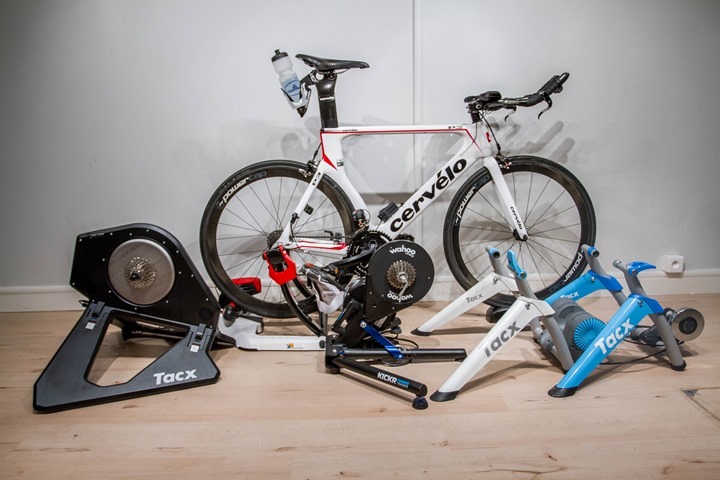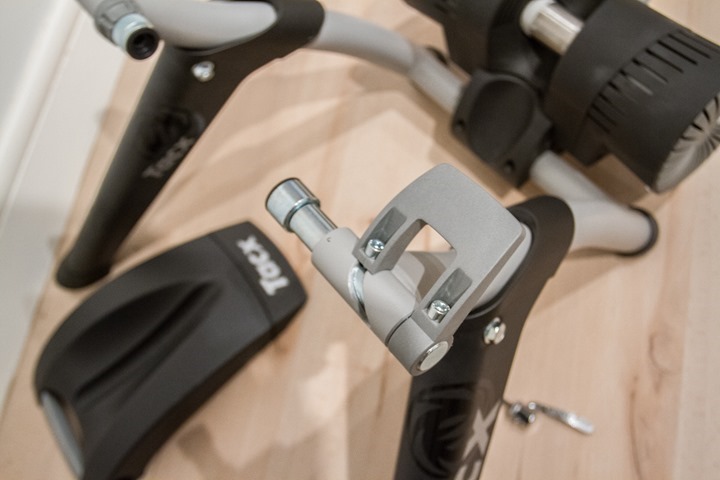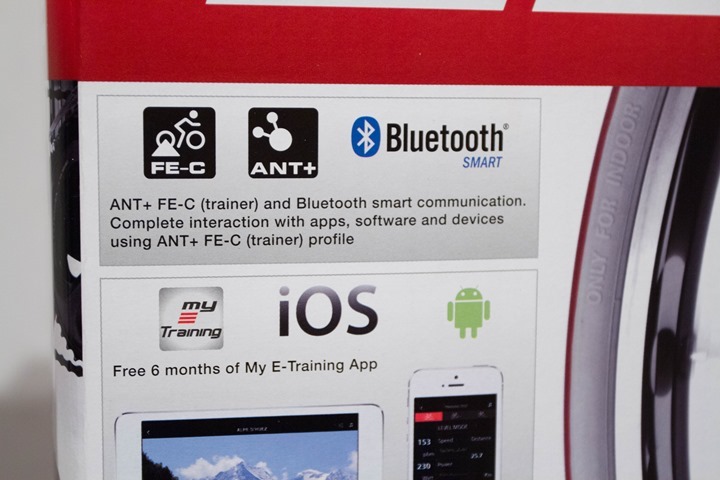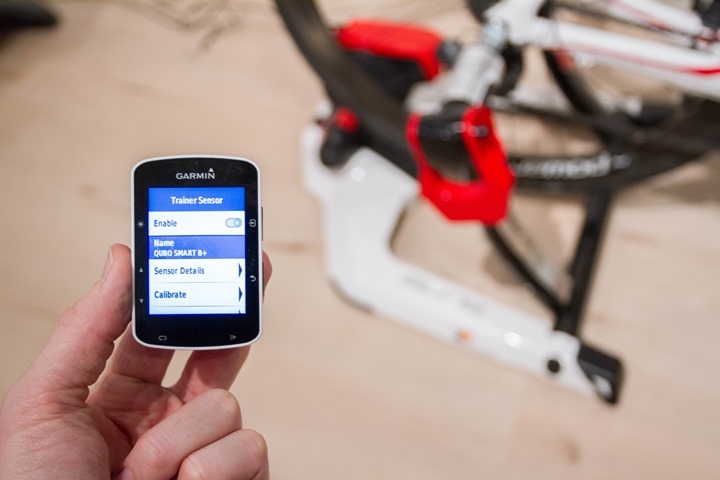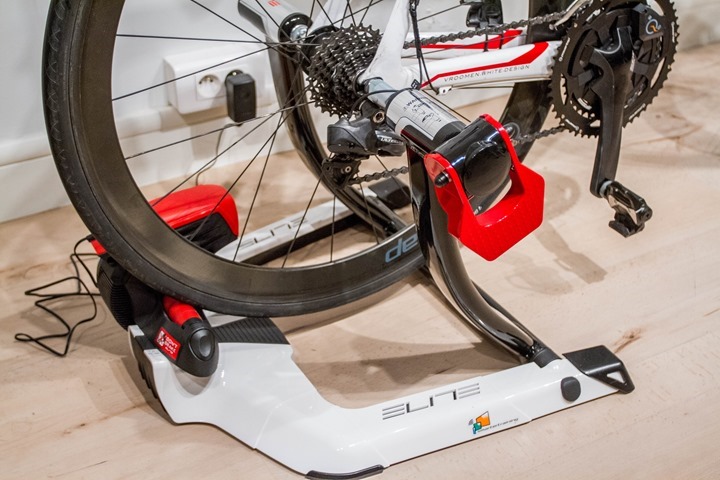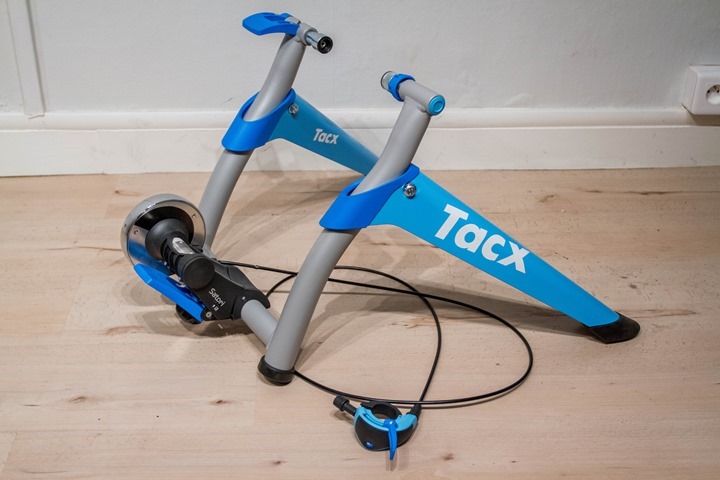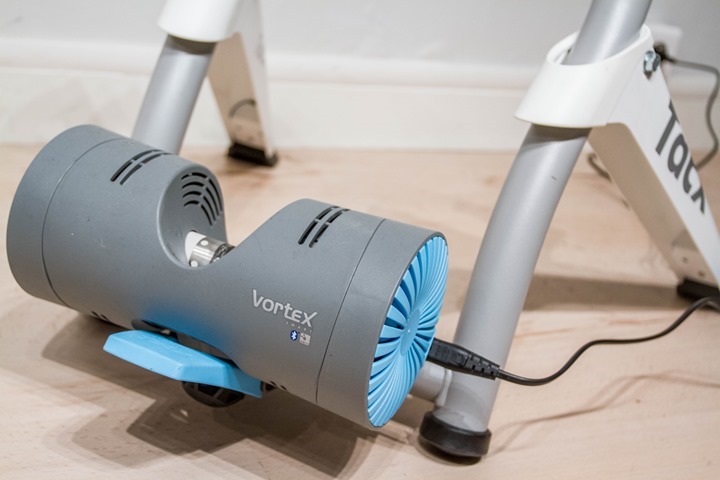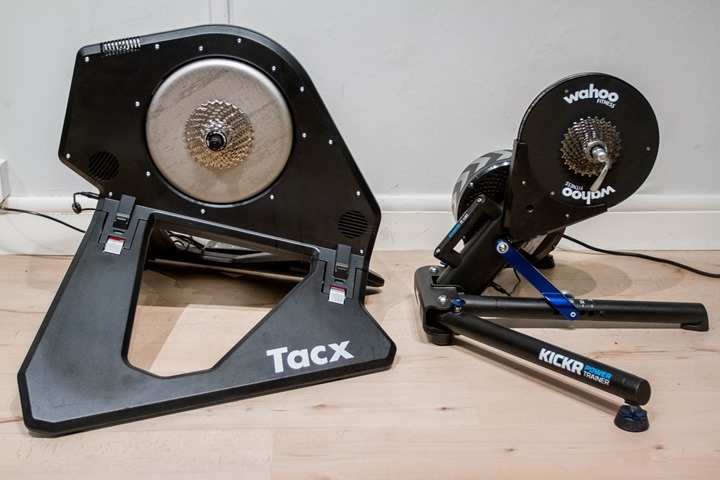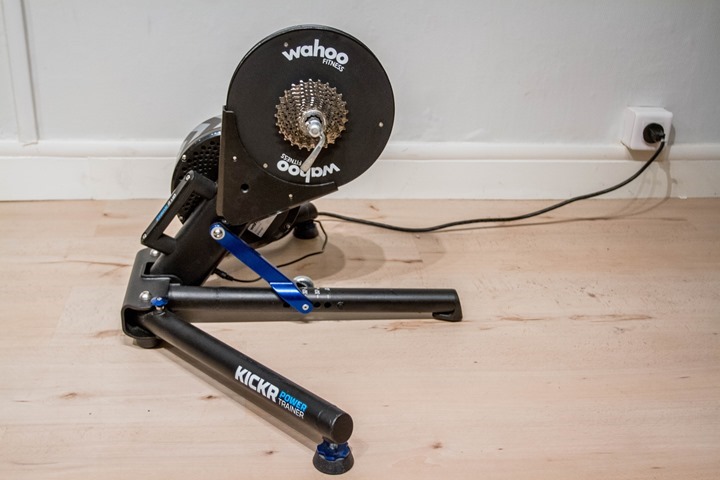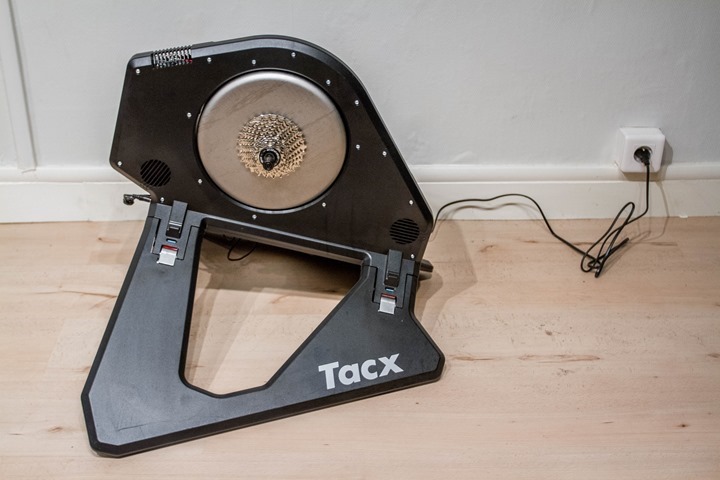!!!Update: Looking for a trainer? Check out my new 2016-2017 Winter Trainer Guide here!
It’s once again fall in the Northern Hemisphere – which for most of us means transitioning to a more steady diet of trainer rides indoors, keeping the outdoor days for those that grace us with better weather. I started doing the Trainer Recommendations post three years ago, and I know many of you are looking for an updated version for this season. We saw a boatload of new trainers over the past few months, predominantly at Eurobike and Interbike.
Generally speaking bike trainer companies release new trainers at those two major trade shows in August and September, though a handful of trainers did predate that slightly in June/July this year. It can however sometimes take a few months for those new trainers to make it to market, thus the reason I tend to post in November, after I’ve had a chance to try them all out. This announcement/release pattern has been the case for years, and expect it to continue.
Now this post will NOT cover trainer apps, rather, I have a dedicated post for that (you can find last year’s version here). I’ll be doing some variant of an update on that later this month, though the gist concepts of that post remains largely unchanged.
Finally, for those looking for general sports technology recommendations (watches/action cams/activity trackers/scales/etc.…), I’ll be publishing those over the next few weeks.
How I make trainer recommendations:
First and foremost, I only recommend trainers I’ve actually used. In fact, that’s why this post is coming out this week and not last week – as there was one last trainer I really wanted to try that would have impacted the standing – thus the delay.
That said, there are undoubtedly many other good trainers, great trainers even – especially in the sub-$300 range out there that don’t have electronics in them. But, even with some dozen plus trainers currently in my possession, I simply can’t try out every one on the market today with any reasonable level of detail or authority. There are some trainers that I’ve used hundreds of times, and others just once or twice.
When I look at recommendations across all products I make, I try and recommend products to you in the same way that I’d do to friends and family. I keep it simple and explain exactly why I feel a given way. My goal is NOT to make a roundup of every trainer on the market, though I will briefly discuss why I didn’t include some trainers in this piece at the end. This is, again, my *recommendations*, not the holy grail of everything ever made.
Price Ranges & Currencies:
The overwhelming trend this year has been in decreasing the mid-range trainers to lower prices than before. Functionalities that were previously only seen at $800-$1,000 trainers, are now seen at $300-$500 trainers. As such, that has kinda dorked with my historical bucketing (sub-$400, $400-$800, and $800+), so I’ve shifted it slightly. They are as follows:
Budget – Sub-$500: These tend to be basic in functions, and lack automated controls, but some do still have some electronics. Most apps support these in a basic manner.
Mid-Range $500-$1,000: These are where we see electronic resistance control, as well as the majority of features and full app integration.
High-End $1,000+: These are the high-end trainers, and primarily distinguish themselves from the mid-range by increasing durability, reducing noise, or just being expensive for the heck of it (i.e. legacy branding/marketing).
Now – you’ll notice the dollar signs, which in this case is implying US pricing. I call this out specifically this year, because the whole pricing business has gotten kinda wonky, especially in the differences between US and European markets. There are specific cases where something may have a vast price gap in one market (i.e. KICKR vs. NEO in the US), yet be nearly identical in other markets (some European countries). Similarly, the European markets generally get a better deal on European-made products (Tacx/Elite), while US consumers tend to get better pricing on US made products (Wahoo).
Next, be wary of purchasing trainers outside your home country (meaning, if in the US, buying from a retailer in Europe). This is because if you have a problem, you’ll be on the hook to pay for shipping of the trainer back across the pond for service. As one who does that regularly, it’s @#$#@ expensive.
And finally, note that I tend to focus on trainers that have some element of technology in them. It’s not that I think that all non-technology trainers are the same (cause they aren’t…well…except that most are), but it’s because that’s just what I happen to review the most here.
Things To Consider:
There’s a lot of things to look for in a trainer – but some are applicable across the board from a sub-$100 unit to a $1,500 unit.
First and foremost, it needs to be sturdy. The more plastic involved, the less likely it’s going to last over time. Take for example, the CompuTrainer, otherwise known as the rock. A tank really. I’m certain I could throw that in front of a semi-truck, and it’d probably be fine. As such, those units last 10-15 years (or more). In fact, I don’t know anyone who’s ever broken a CompuTrainer frame. Some electrical components eventually wear out, but the frame is astoundingly sturdy. I find the KICKR family in that same camp. It’s a beast component-wise.
Second, look at the attach point to your bike. I’ll start with the ones that leverage a skewer of some sort and don’t require removal of the wheel. In these cases, try to find one that has a ‘quick-release’ mechanism for quickly locking the trainer into place. One that doesn’t require you to endlessly spin the tightening lever and try to find an exact spot each time. See below for an example of a quick lever:
In the case of trainers that you attach your bike directly into a cassette mounted on the trainer – called ‘Direct Drive trainers’ (Muin/NEO/KICKR/LeMond/etc…), be sure that it’ll be compatible with your bike. There are only a few edge cases where this occurs (primarily higher end), but just be aware of them.
Third, look at how stable the platform is. The smaller the base of the trainer, the more likely it is to tip over (and you along with it). And while tip-overs are extremely rare – they are a problem on lower end trainers ($50-$150) where the base is really small. This can be further compounded when the trainer mounts the wheel higher up – meaning a higher center of gravity. It’s not hard to get a situation where you try and reach for a TV remote control or something off to the side and fall over. None of the trainers I’m recommending have this issue, but in general, keep it in mind.
Some Technical & Communications Terms:
Ok, we’re almost to the recommendations. But we need to all be on the same table when it comes to some of the technical terms that we’re going to talk about. Notably, the protocols and communications side of how trainers talk to apps.
In the sports world there are essentially two camps: ANT+ & Bluetooth Smart. Virtually all devices use one or both of these low-power technologies to transmit and capture information such as heart rate, power, speed, cadence, and more.
In the trainer realm, that means trainers tend to support two types of things over these protocols. The first is simple broadcasting (one-way) from the trainer to the app/device that you’re using. This is done for the following on trainers:
ANT+ Broadcast: Power, Speed, Cadence
Bluetooth Smart Broadcast: Power, Speed, Cadence
Compatible devices, such as a Garmin Edge 500 or a Polar V800 can pickup these signals and record them. Some trainer companies support broadcasting on both standard (Wahoo, Tacx Smart Trainers), while others pick a given side (CycleOps PowerBeam you buy a unit that’s either ANT+ or Bluetooth Smart). And yet further, Elite partially supports it by doing broadcast of Bluetooth Smart but not ANT+ (except FE-C).
Next, for control there are basically two ways trainers can be controlled via apps:
Private communication channel: Over private-ANT or private Bluetooth Smart, or heck, even wired in the case of the CompuTrainer.
Open/Standard Communication Channel: Over ANT+ via ANT+ FE-C.
For ANT+ FE-C, devices such as the Garmin Edge 520 & soon the Edge 1000 support controlling the trainer straight from your Edge. This also means you can re-ride your outside rides (elevation changes and all) without any other software.
So what about Bluetooth Smart control? Well today there actually isn’t a standard trainer control over Bluetooth Smart. Rather, each company does their own thing and shares it with developers. So, Wahoo has their variant of a BT Smart control implementation (that everyone supports), CycleOps has theirs, and Elite has theirs. Tacx took an interesting spin and simply wrapped the ANT+ FE-C standard inside a Bluetooth Smart wrapper and called it done (making it easy for app developers). Either way, things are a bit messy here. Here’s what each major manufacturer does there:
Wahoo: ANT+ FE-C on KICKR SNAP, and KICKR coming in November. Also gives developers access to Bluetooth Smart control.
Tacx: ANT+ FE-C on all ‘Smart’ branded trainers (except Satori). Also gives developers access to Bluetooth Smart control.
Elite: ANT+ FE-C on certain supported trainers. Also gives developers access to Bluetooth Smart control.
CycleOps: Gives developers access to private-ANT control, and Bluetooth Smart control methods.
BKOOL: ANT+ FE-C on all electronic trainers.
CompuTrainer: Gives some developers access to WiFi and wired control.
This all matters when it comes to apps – but the thing you need to know is that you want your trainer to be dual capable, and should ideally support if you want resistance control across a broad number of apps.
Budget Trainers (sub-$500):
This category has historically been for non-electronically controlled trainers. Basically trainers that you can’t control via electronics, but might be able to control via a lever or just from fluid resistance. This year though that’s changed. Prices have dropped and now there’s some legit options in here that do have control components.
Elite Qubo Digital Smart B+:
This was the last trainer I was waiting on, and the reason this list was delayed. The Qubo Digital Smart B+ is the least expensive automatic resistance controlled trainer on the market. In the US it’s in the $450-$499 range (seems all over the map, but in Europe about from 275-329EUR, so at that price you’d consider the Tacx Vortex Smart instead depending on current prices). But again, seems to vary a bit (ok, a lot).
(Pricing notable: Researching MAP prices vs real prices makes this particular trainer category a mess. The prices for some of these companies are all over the map depending on discounting. So basically if you’re talking $499USD, then spending $30 to get the Bushido Smart probably makes more sense. But if you’re talking $400-$450 on some sort of sale/discount, then you may want to Qubo. Confusing, yes.)
Anyway, for the resistance control that means that this trainer can be controlled by apps and automatically adjust the resistance if you were going up a hill, or for pre-programmed intervals. Though, when doing vast shifts in power (i.e. 100w to 450w, it’s a bit slower to change than some trainers that cost $500 more, about 1s per 50w of power shift). Again, tradeoffs.
This trainer supports the ANT+ FE-C standard, which means that a wide variety of apps can control it via ANT+. On the Bluetooth Smart side, it’s basically the same as Tacx whereby Elite has released/announced support for 3rd party developers and some are already working on Bluetooth Smart support (TrainerRoad & Kinomap). For now though the major apps like Zwift, TrainerRoad and Kinomap can already control it via ANT+. Plus their own app, which can be used via Bluetooth Smart too. One other minor caveat is that the Elite trainer line doesn’t broadcast your power/speed/cadence over standard ANT+ channels (thus your Garmin can’t pick it up). But it does do Bluetooth Smart, and also does ANT+ FE-C, so it can at least control it and record it.
The trainer has a nice quick-release system making it super quick and easy to plop the bike in, plus, no need to use the swirly knob to tighten it down as it uses your own body weight to press the trainer onto the roller. That does though have the disadvantage of being slightly less accurate for power data if you lean forward on your bike (triathlon bike for example), though it’s spot-on when your weight is shifted back. But for the price, it’s not a horrible compromise.
(Tip: Be sure you don’t get confused on models with the Qubo when looking at pricing, like I did initially – as there is a slight difference between the cheaper Qubo Power Smart B+ and the Qubo Digital Smart B+. The Digital supports ANT+ FE-C, the Power doesn’t.)
Tacx Satori Smart (Mostly Euro Pricing):
This is the least expensive ‘Smart’ branded trainer from Tacx, at $399US, but significantly cheaper in Europe at about 225EUR. Their ‘Smart’ trainer lineup broadcasts your power/speed/cadence over ANT+ & Bluetooth Smart. It does NOT have ANT+ FE-C control though because it doesn’t have automated control. Instead, you have a little lever connected via cable. But otherwise it’ll give you your power and other metrics and let you connect your Garmin, Polar, or other App to read it. Accuracy-wise it’s fairly good once you’ve done calibration on it using the procedure in the app.
Now, you’ll notice the caveat about being Euro pricing focused. That’s because this is an example where the US pricing is way more expensive than the European pricing. So you may want to figure out what’s most important to you (control or broadcasting power) and go with that between this and the Elite above it. The Satori doesn’t allow automated control, but does open-broadcast ANT+/BLE Speed/Power/Cadence. Meanwhile, the Elite does allow automated control, but doesn’t broadcast open ANT+ Speed/Power/Cadence (but does on BLE). Confusing, ehh?
$100-$200 Trainers:
This is a tough category, because there are so many entrants here and I’ve only used a few. And quite frankly, they’re all pretty similar.
My general recommendation is to check out the Travel Trac Magnetic Trainers that Performance Bike offers (these are also branded under various other names worldwide). The key thing is that you want to ensure it can handle an appropriate amount of watts. For that I’d swag 300w for those just getting into the sport, but probably more like 400-500w if you’ve got a bit more strength. If you’re on the pointy end already, then you’ll already know your max wattage and already know you probably need more.
The most important thing is ensuring that it meets some of the characteristics that I talked about earlier in the post on things to look at (materials, build, stability, lever for control, etc…).
Finally, if you’re spending more than $200 in this category, you should really be looking at other automated resistance options. About the only reason to spend more and get less is if you’re trying to get a trainer that supports a very high level of resistance (i.e. 1,000w), which some of the lower end trainers will fail at providing.
Sub-$100 Trainers:
In the past I’ve recommended ‘Little Red’, and that was a great option at about $79-$89 on sale at Performance Bike (Tip of the day: Performance Bike has sales basically every other week for their house-branded items, so if it’s not on sale this week, it probably will be next week. This isn’t applicable to non-house branded trainers).
The problem is Little Red went away. Instead, they’ve introduced another – the Blackburn Mag 1 Trainer for roughly the same price. In looking at the specs, the main difference between this and the one in the category above is the resistance control. As of today, the price difference is only $10, so honestly I’d go with the Travel Trac Mag+ at $99, but if not on sale, then it’s harder to justify.
One thing to keep in mind is that trainers in this category tend to have a max wattage of about 300 watts. Again, for most people just getting into the sport, 300w isn’t too bad. But it’s something to be mindful of if you plan to do intervals harder than that. Either way, for $80-$90, these are great deals.
Mid-Range Trainers ($500-$1,000):
While this is a vast price range, it’s actually fairly easy to pick a winner here. There’s only one unit that has everything, and does so at a price towards the lower portion of the range.
Tacx Vortex Smart:
The Tacx Vortex Smart is a fully ANT+ FE-C capable trainer that allows you to control resistance via automation and applications. It also transmits both ANT+ and Bluetooth Smart Speed/Power/Cadence over all the normal protocols, so basically any device and app on the market can pick it up. In the US it’s priced at $629 now $529, and in Europe I’m seeing it in the low 300EUR’s. That makes it 220EUR cheaper than the KICKR SNAP in the US, or a mind-boggling 550EUR+ cheaper. Damn!
Accuracy-wise once calibrated it’s quite accurate, though getting it setup the first time for your bike can be a bit finicky with the way the press-on lever works. But once that’s done – you’re good to go from there on out (future rides).
While 3rd party apps can control the trainer via ANT+, Tacx only recently opened 3rd party Bluetooth Smart control to the Smart trainer lineup – so apps are still rolling out support there. But all the big ones (Kinomap, Zwift, TrainerRoad, etc…) already support ANT+ FE-C, so it’s not really too much of an issue.
Finally, for those trying to figure out the difference between the Vortex Smart and the Bushido Smart, the Bushido doesn’t require power from an outlet. The Vortex does. I just don’t see that being worth $300 for most people. Or heck, even $50 unless you train outside on a trainer a lot such as at a race start.
If you’re looking for a mid-range trainer – the Vortex Smart is it. Oh, and just make sure it’s got the ‘Smart’ label, and isn’t the older non-Smart Vortex.
High-End Trainers:
The high end has seen a slight addition here – but not a major change. Over the last two years, I’ve recommended the Wahoo KICKR, and that’s no different this year. But I’m also giving the nod to the Tacx NEO in certain situations. More on that in a second.
Wahoo KICKR:
Once again the KICKR tops the list, for two key reasons: App compatibility & price point. On the app side there is no trainer that’s compatible with more apps than the KICKR. Some 20+ apps at last count that can control the device. When it comes to trainer apps, you want more choice – not less. Next, on the price side it’s at $1,099/$1,199 depending on which cassette you have it shipped with (or 1,299EUR). This is a key point that I think some might miss on the NEO or Elite Turbo Muin, in that for both of those you have to buy a new cassette for it ($50-$100). Further, you have to buy the tools to install that cassette on it (or, get your local bike shop to do it for you).
Some users have over the last year or so noted oddities in power accuracy, which vaguely seem to be related to when units were produced. Though, Wahoo says they’ve now hired a person who’s entire job in life is accuracy testing of trainers. Wahoo also released a series of firmware updates since, which target both accuracy as well as the ability to have your trainer match your existing power number.
Now the one downside of the KICKR is that it’s not silent. It’s roughly the same in decibels as other trainers, though some describe it as a slightly higher pitched sound (I’d agree). Not that it really matters too much, it’s still in that ballpark.
Ultimately, if I’m going to recommend a $1,000+ trainer, it’s going to be the KICKR. Its ability to integrate with virtually everything (and FE-C coming later this month), and still broadcast power and speed on both ANT+ & Bluetooth Smart is clutch.
Tacx NEO:
This is new this year (both to the market, and my list). The NEO’s claim to fame is its noise properties. Or rather, lack thereof. It aims to be the quietest trainer on the market. And I’d agree – I don’t know of anything that’s more silent than this. That’s all while having ANT+ FE-C compatibility, as well as ANT+ transmission of power/speed/cadence to any capable device. And finally, Bluetooth Smart control as well.
Now, there does seem to be some teething and/or quality control issues on early produced units, resulting in odd sounds. I can’t well tell if this is 5-6 people (out of thousands of units shipped), or more. But Tacx does seem involved and working closely with folks seeing those issues, so hopefully it’s just getting the kinks worked out. If I see expansion of this over the next weeks, I’ll note it – but I don’t expect to see this be any sort of systematic issue as more just a initial batch working its way out. I also think there’s probably a bit of expectation setting in cases where people’s shifting/drivetrains are louder than they realize. Your bike is still going to make some noise, noise which has nothing to do with the trainer.
The NEO is more expensive than the KICKR, at $1,699US. For Europeans, this NEO is much closer in price to the KICKR, only 100EUR difference at 1,299EUR + the cost of a cassette (about 50-100EUR). So that’s something to heavily consider.
In my opinion, the primary reason you’d get the NEO over the KICKR is that you want near-silence. And in my experience – it does deliver on that quite well. There’s also a slight gap right now on the Bluetooth Smart control side for 3rd party apps (notable for iPhones/iPads that can’t do ANT+). Tacx released access for developers to control all Tacx Smart trainers via Bluetooth Smart the last week of September, so we’re still seeing some apps get that all baked in. I expect that to settle out by December though – thus putting them on the virtually same app playing field as Wahoo.
The Why I Didn’t Include It List:
First and foremast, this isn’t a list of bad trainers. If you take that away from this paragraph, then you’re mistaken. Instead, it’s just to save me time answering the same question 482 times below for each trainer as to why I didn’t include them. I’m keeping these explanations short and sweet. In many cases I’ve detailed out longer answers in posts related to those products.
Wahoo KICKR Snap: Great product, great app compatibility, but overpriced compared to Tacx Vortex Smart, especially once any remaining apps out there implement BLE control on Tacx. If the KICKR Snap were say, $650, then I’d give it the nod over the Vortex simply because it’s got a more robust build (better materials).
CompuTrainer: Solid physical product (build/accuracy), horrible software, overpriced compared to KICKR (or even NEO). Just outdated. But, if you can get a used one on eBay for about $600, that’s a good deal. I wouldn’t pay any more than that.
Elite Real Turbo Muin B+: While one of the first ‘quiet’ trainers, there’s some minor quirks that cause loss of top spot. Notably lack of broadcasting over standard ANT+ (but does support FE-C for control), also slightly slow response of resistance (can only change/shift 40-50w per 1-second). Given it’s priced similarly to KICKR/NEO, just little reason to buy it.
LeMond Revolution Pro: The company has folded and ceased operations too many times in such a short time. While it was a good (albeit crazy loud) product, from a consumer standpoint it just doesn’t make sense. Plus, technically speaking the Wattbox isn’t up to par with many other solutions on other trainers today.
PowerBeam Pro & PowerSync: While technically a very capable trainer, it lacks the ability to do dual ANT+/BLE. For that singular reason, it doesn’t make the list. Otherwise, it probably would. In such a shifting landscape of apps, you don’t want to be locked in on one protocol or the other. I’m only recommending purchasing trainers that are dual-capable.
Tacx Genius Smart: This trainer is different from the other Tacx units in that it can actually spin the wheel by itself, thus simulating downhill sections. While fun for a ride or two, I don’t find it worth the extra money.
Tacx Bushido: While it has more incline simulation capability (15% vs Vortex Smart at 7%), that really only impacts you if you’re doing hills above that. It’s about the slow speed, and not actually the total wattage output. Further, if you’re really set on spending that money, then the KICKR SNAP is $849 vs $799, so very close. But it gives you slightly better app compatibility and a much beefier frame. The SNAP also gets you up to 10.3% incline, so not as much as the Bushido, but covers it for most. There are other nuances, but that’s the gist of things.
Kurt Kinetic Trainers: While in the past I’ve recommended these (Road Machine especially), their new pricing model this year just isn’t logical. They’re no doubt great trainers (but not smart trainers, despite the new branding otherwise), but increasing the price on something that has less technology than ones half its price just isn’t sustainable, or something I can recommend.
BKOOL Trainers: Again, another perfectly capable trainer – but just doens’t make sense pricing wise. It’s basically the same price as the Tacx Vortex, but unlike the Vortex it doesn’t broadcast on Bluetooth Smart. Nor does it broadcast ANT+ Power/Speed/Cadence. It does support ANT+ FE-C though.
Trainer FAQ:
Most of this is from years past, but I wanted to repeat it for this year. I’ve tweaked things where appropriate and/or where they’ve changed.
What about trainer tires?
I commented on trainer tires a while back in a Weekly Mailbag post, so here’s what I said then – which still applies today.
I train everyday on the stock wheels and tires that came with the bike. Just normal tires and normal wheels. In fact, I don’t even bother to swap out for a separate trainer tire. Why? Well, my thinking is that I spend 3+ days a week on a trainer, and the last thing I want to deal with is swapping tires or wheels every time I go inside to outside or the inverse (I’m kinda lazy that way). Further, when you step back and look at the total cost of triathlon or cycling, and the total cost of simply getting a new tire each year due to wear – the new tire is pretty low (between $30-45).
Now, if you’re riding race wheels with expensive race tires – you’ll have to balance the much higher cost of most race tires.
Do trainer tires make it quieter?
Nope, actually, not at all. And I proved this as part of my Tacx Genius review – some actually make it louder. I’ve then further confirmed this with a few other tire companies as well. Most of them kinda silently laugh at the fact that people actually buy expensive trainer tires. Hint: Just use last season’s tire and toss it at the end of the winter.
Why didn’t you recommend XYZ trainer or software instead? It’s way better!
As noted above, it’s likely because I haven’t used it. I’m pretty strict in that I don’t recommend things I haven’t used or know a lot about. I know magazines love to, but I don’t. Sorry!
Any tips or suggestions on where to place remote controls/jelly beans/bike computers/etc. while on a trainer?
Yup, you’re in luck. I’d recommend either a simple 4-cup OXO measuring cup (silly, I know, but clips onto almost all road bike bars and triathlon bike aerobars – awesome). Or, you can build your own like I did here in this post.
Do you use a trainer pad/mat (floor protector)?
Yup, it’s just a generic one I picked up at Performance Bike way back when. You can find endless numbers of them online or at your local bike shop – usually around $30. You can also just use a towel, just be sure that if you’re on carpet that you change the towel regularly, otherwise it’ll eventually stain the carpet below (sweat going down into it). Here’s the thing, don’t overspend on this – that’s silly. You don’t need a $70 trainer mat. As long as it’s waterproof (thus, sweat proof) and offers some padding to lower sound profiles, that’s really the key thing.
What’s the quietest trainer?
Outside of the Tacx NEO, I’ve done a lot of testing on this in the past. Each trainer, multiple iterations, videos, differing speeds (which is what control sound levels on trainers, not resistance/wattage) – and did them all in front of a decibel meter (measures sound). I think I did them for three hours in total. I suspect my poor neighbors below thought civil war had broken out above their heads.
But here’s the thing: They’re all within about 1db of each other at their peaks (and about the same across the rest of the profile). Well, except the LeMond Revolution – which was 20db higher and topped out at 100db, which is literally the same as a jet engine. No joke. Of course, everyone knows it sounds like a jet engine – but this literally proved it.
The Elite Turbo Muin variations are quieter than most of them – but not completely silent or as quiet as the Tacx NEO.
What about generic rollers, any thoughts?
I don’t have a ton of experience on rollers unfortunately.
In any event, I find that the cross-over between people who really like riding rollers and the people who really like the technology aspect tends to be rather small. Said differently, roller people tend to be more purists who don’t want technology in the way (not all of course, but most). The one thing I do like about the Inside Ride unit is that the bumpers make it a bit easier to get used to riding rollers versus units without that, plus they support the ANT+ FE-C. So if I had to pick a pair of rollers, I’d go that direction.
What about one of those bike protective thong cover things?
No, sorry, I don’t cover up my bike. I’ve spent a A LOT of time on my bike, pouring a lot of sweat – many multi-hour rides. But you know what? I’ve never seen any adverse issues due to it. Perhaps I’m lucky, perhaps it’s not normal. Either way, I don’t use one. That said, Tacx just released a cool one that actually has a cell-phone holder built in (with a protective plastic cover). Kinda neat.
Do you use a trainer block? Which one do you recommend?
Yup, I have a couple floating around. In general, don’t go overboard here. Pickup something cheap and call it a day. I’ve got the CycleOps climbing block – which is somewhat handy in that it has basically multiple levels on it. I don’t use that for climbing per se, but just to handle differences in the different trainer heights. It’s $23. But there are other cheaper ones that start at about $11. Most of those are fine (I have a few of those too). Just be sure it can support your weight.
Support the site, and even save 10%!
If you’re looking at any of the above devices, you can support the site by purchasing through any of the below links. Here’s a handy table of everything mentioned above that I have a review on. And remember that everything you purchase through Clever Training saves you 10% off your entire cart – so that will definitely help in some of the trainers cases. You’ll use coupon code DCR10BTF and you’ll also get free US shipping for all items over $75. For the Wahoo KICKR, you can still support the site using REI with this link (no discount though).
| Product | Amazon | |
|---|---|---|
 | Elite Qubo Digital Smart B+ $499/329EUR | N/A |
 | Tacx NEO Smart $1,369 | Amazon |
 | Tacx Satori Smart $399 | Amazon |
 | Tacx Vortex Smart $529 | Amazon |
 | Wahoo Fitness KICKR V1/2013 $1,199 | Amazon |
Thanks for reading! And feel free to drop any questions below, I’ll be happy to answer them.

